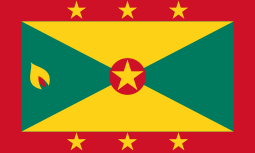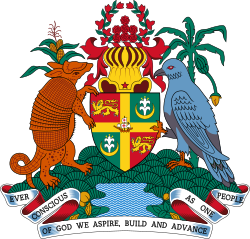People's Revolutionary Government (Grenada)
The People's Revolutionary Government (PRG) was proclaimed on 13 March 1979 after the New Jewel Movement overthrew the government of Grenada in a revolution. The government suspended the constitution and ruled by decree until a factional conflict broke out, culminating in an invasion by the United States on 25 October 1983.
People's Revolutionary Government of Grenada | |||||||||
|---|---|---|---|---|---|---|---|---|---|
| 1979–1983 | |||||||||
Motto: Workers of the world, unite! | |||||||||
 | |||||||||
| Capital | St. George's | ||||||||
| Common languages | English | ||||||||
| Demonym(s) | Grenadian | ||||||||
| Government | Unitary Marxist-Leninist one-party socialist parliamentary constitutional monarchy | ||||||||
| Monarch | |||||||||
• 1979–1983 | Elizabeth II | ||||||||
| Governor-General | |||||||||
• 1979–1983 | Paul Scoon | ||||||||
| Prime Minister | |||||||||
• 1979–1983 | Maurice Bishop | ||||||||
• 1983 | Bernard Coard | ||||||||
• 1983 | Hudson Austin | ||||||||
| Historical era | Cold War | ||||||||
• Communist rule proclaimed | 13 March 1979 | ||||||||
| 25 October 1983 | |||||||||
| Area | |||||||||
| 348.5 km2 (134.6 sq mi) | |||||||||
| Currency | East Caribbean Dollar | ||||||||
| ISO 3166 code | GD | ||||||||
| |||||||||
| Today part of | |||||||||
History
The New Jewel Movement (NJM) under the leadership of Maurice Bishop was the main opposition party in Grenada during the 1970s. In 1979, the NJM overthrew the government of Eric Gairy, which had ruled the country since independence in 1974. The NJM launched an armed takeover of the radio station, police barracks, and various other key locations in Grenada while Gairy was on a trip outside the country. The armed takeover was conducted by the National Liberation Army (NLA), which had been formed in 1973 as the military wing of the NJM.[1]
The NJM suspended the constitution and announced new laws. Maurice Bishop announced the formation of the PRG over radio, which organized a cabinet to run the country with Bishop as prime minister. All political organizations except for the NJM were banned, and membership in the NJM was thereafter tightly controlled.
Maurice Bishop expressed his objective: "We are a small country, we are a poor country, with a population of African slave descendants, we are part of the exploited Third World and, definitively, our challenge is to seek the creation of a new international order that puts the economy at the service of the people and social justice". The new government worried the United States, which had previously supported Eric Gairy, and whose ambassador warned: "The United States government would dislike any inclination on the part of the Grenadines to develop closer ties with Cuba
The regime was particularly active in developing social policies: a Centre for Popular Education was established to coordinate government initiatives in education, including literacy campaigns. The learning of Grenada Creole was allowed at school. Nevertheless, the Bishop government's tendency to marginalize the Church's role in education contributed to the deterioration of relations with the clergy. In the health sector, medical consultations were made free of charge with the help of Cuba, which provided doctors, and milk was distributed to pregnant women and children. In economics, the authorities were setting up a system of financial loans and equipment for farmers, and agricultural cooperatives were being set up to develop the activity. The Bishop government was also working to develop infrastructure, including building new roads and upgrading the power grid. Finally, the government was attacking marijuana growing operations to promote food agriculture and reduce violence. The PRG established close relations with the government of Cuba and, with Cuban assistance began construction of a large international airport.
Internationally, Grenada was increasingly isolated. The United Kingdom suspended its economic assistance and the United States used its influence to block loans from the IMF and the World Bank. The situation was also deteriorating internally: on 19 June 1980, a bomb exploded during a meeting during which Bishop was to intervene. The device killed three people and wounded 25. Bishop openly accused "American imperialism and its local agents". However, the real responsibility of the CIA was uncertain; if it had indeed imagined destabilization operations, the Carter administration was opposed to them. In 1983, Bishop finally went to Washington to try to "negotiate peace".
Literacy and health statistics improved dramatically during Bishop's tenure, but economic woes led to a crisis. In 1983, internal divisions occurred within the central committee of the PRG. A group led by Deputy Prime Minister Bernard Coard, a hard-line militaristic element,[2] attempted to convince Bishop to enter into a power-sharing agreement with Coard. Eventually Coard placed Bishop under house arrest and took control of the PRG government. The removal of Bishop led to large popular demonstrations in different areas of the country. In the course of one of these demonstrations, Bishop was freed by the crowd, and eventually reached the PRA headquarters at Fort Rupert.
A unit from the PRA (People's Revolutionary Army) at Fort Frederick was dispatched to Fort Rupert. Fighting broke out between that force and the civilians at Fort Rupert resulting in many deaths. Afterwards, Bishop and seven others, including several cabinet ministers, were rounded up and executed.
After the executions, a new government called the Revolutionary Military Council, led by General Hudson Austin, was formed to rule the country and the PRG ceased to exist. This government nominally ruled for six days before being ousted by the United States invasion of Grenada.
References
- Joseph Ewart Layne, We Move Tonight: The Making of the Grenada Revolution, (Grenada Revolution Memorial Foundation, 2014), 2-3.
- País, Ediciones El (19 August 1994). "Reportaje | 'Apocalypso now'". EL PAÍS (in Spanish). Retrieved 6 June 2017.
External Links
"Grenada: ‘A Lovely Little War’" by Bill Bigelow, The Zinn Education Project, 20 October 2013.

